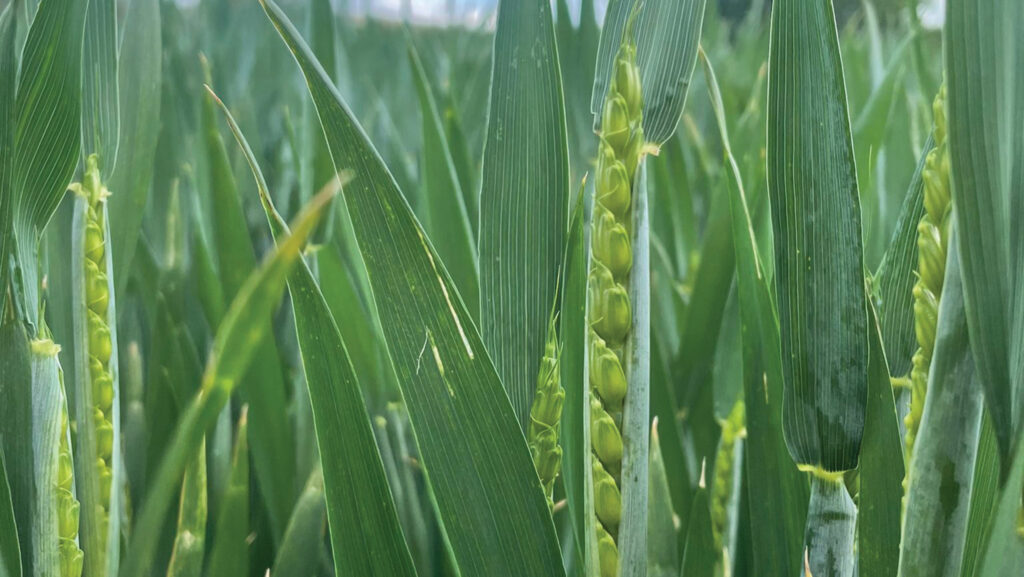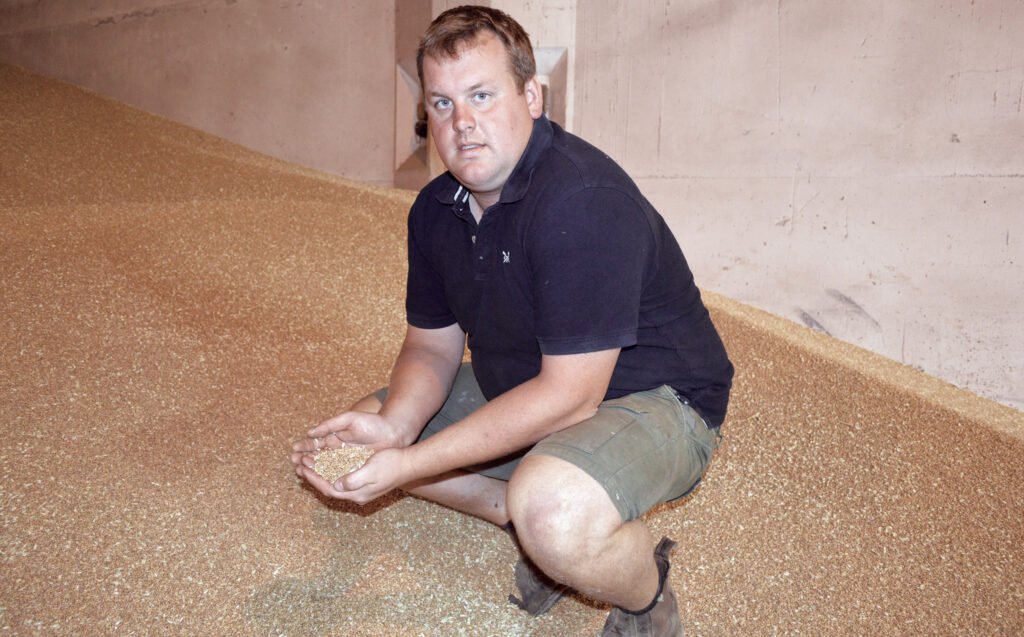Advice on getting the most from Dawsum winter wheat
 © KWS
© KWS One of a strong line-up of hard feed wheats available to growers, Dawsum accounts for almost 20% of all the winter wheat being grown in the UK this year.
Joining the Recommended List in 2022, the favoured Group 4 variety is one of 11 hard feed types included, sitting mid-table on a UK treated yield of 103% and an untreated yield of 91%.
Its popularity is due to a combination of factors, say commentators, who point to its Costello/Kerrin parentage.
See also: Wheat yield prompts fungicide shift on Nottinghamshire farm
From Costello it has inherited its very high specific weight and excellent yellow rust resistance, but also a reluctance to get going in the spring, while Kerrin’s contribution is consistency of performance across regions, soil types and later drilling dates.
The RL data shows Dawsum delivering a yield of 106% when it is drilled early – before 25 September – but that’s unlikely to suit every situation or help where grassweeds are prevalent.
Dawsum’s wide drilling window is a bonus, but it needs careful consideration, says John Miles, seed technical manager with Agrii, as the variety’s septoria rating may be tested if it is drilled too soon.
“If you drill it in September, rather than the second or third week in October when the RL trials are drilled, you need to amend the septoria score accordingly,” he advises.
“It’s RL septoria rating is a respectable 6.3, but if it goes into the ground in mid-September, it will be more like a 5. Our work shows that septoria scores should be adjusted by 0.3 a week as you move drilling date.”
Top-selling UK winter wheats by market share
- Dawsum 19.8%
- Extase 14.8%
- Champion 9.1%
- Skyfall 6.4%
- Crusoe 6%
- Skyscraper 5.5%
Source: Agrii
He acknowledges that the lure of drilling in September is stronger than ever, and that the 2023 growing season was a stern test for any variety.
“Last year was a bad one for septoria, just as it was for lodging. We saw some surprises in the field.”
His advice for those who want to drill Dawsum in September is to be mindful of septoria and realistic about fungicide spend.
The variety’s 7 rating for resistance to lodging also came under some pressure last year.
John recalls that fertiliser was applied in February, but there was then no opportunity to get plant growth regulators on until April.
“It meant that much of the wheat crop put on growth without any regulation. When we had stormy weather close to harvest, we saw both wheat and barley affected.”
John highlights Dawsum’s high specific weight of 79.9kg/hl, which has held up well in the field. “There’s nothing that you can do or apply to manage specific weight up, so a high value always appeals.”
Breeder’s view
Dawsum is one of the lowest risk varieties in the hard Group 4 sector, says Dr Kirsty Richards of breeder KWS.
This spring, with greater demand on machinery, it is imperative to manage workloads as best as possible, and utilising the disease-resistance properties of Dawsum can really help.
For example, Dawsum’s strong 9 rating for yellow rust resistance will allow growers to stretch application windows if the weather is not on their side.
To underline this, Kirsty says KWS carried out work in the 2022-23 season looking at wind speed data on the 20 days either side of a normal T1 spraying date.
“Results showed many counties experienced 40% of days with an average wind speed of over 10mph,” she says.
“So, in that critical T1 period, only three out of every five days were potential spray days, and that is before you take into account other limiting factors such as rain.
“In short, its disease resistance can buy you valuable time at spraying without compromising control.”
While there are varieties on the RL with higher septoria resistance scores, in the field Dawsum’s score of 6.3 has proved a useful variety feature, she says.
“Trials carried out with Corteva have shown Dawsum to have a good untreated yield, but it also responds very well to fungicides, with an additional 1t/ha resulting from suitable fungicide treatment even in high-pressure years.”
The conditions that developed before the 2023 harvest showed that it isn’t infallible when it comes to lodging, and any reduction in PGRs should be considered very carefully, she advises.
Otherwise, early spring management should target a plant population of 260 plants/sq m, with each plant carrying between three and four tillers.
“Any more than this and you get a structure that is hard to support.”
Case Study: Henry Ruffle, Suffolk

Henry Ruffle © MAG/David Jones
Dawsum has been grown for the past two years at John H Ruffle & Son near Ipswich, initially for seed for Frontier Agriculture and now as a commercial crop.
High-yielding feed varieties are the basis of all the wheat grown on the 900ha farm, and Henry Ruffle is always keen to get his hands on new variety introductions and put them through their paces.
He took the opportunity to grow some Dawsum for harvest 2022 when it was offered, and has been pleased with the variety’s consistent performance.
“It was in a class of its own in 2022,” he says. “We had a very high yield and a fantastic specific weight.”
As a result, it has replaced Insitor on the farm, with Champion also being grown on a commercial basis.
“Despite being very different, they both have a place here and Champion has the blossom midge resistance that Dawsum doesn’t.”
Wheat drilling takes place any time after the last week of September, depending on the conditions.
“We have also drilled some Dawsum very late in the season, without any significant penalty,” Henry says.
Last year’s wet weather prompted him to use a comprehensive four-spray programme based on the strongest chemistry.
A tebuconazole-based T0 was followed by Revystar (fluxapyroxad + mefentrifluconazole) at T1, Univoq (fenpicoxamid + prothioconazole) at T2 and Prosaro (prothioconazole + tebuconazole) at T3.
“It was the right approach. It really helped in a difficult season and kept the crop clean,” he says.
He did see some lodging in Dawsum for the first time in 2023, he admits. “We use sewage sludge here, which might have been responsible, but it was quite a bad year for lodging across the board.”
Henry points out that Dawsum is one of the last varieties to get going in the spring, which can be very noticeable where it’s being grown alongside a more vigorous variety which wakes up early.
However, “it doesn’t seem to make any difference to the end result”.
Agronomist’s View
Ben Abell, head of agronomy at Dyson Farming, has plenty of experience with Dawsum, having overseen 820ha of the variety last year.
Grown as a first wheat, it gave an average yield of 10.6t/ha across all of the company’s farms and did 11.05t/ha in Lincolnshire – the highest yielding variety they grew.
In 2022, when the business had 120ha of Dawsum, it was right up there alongside Cranium in terms of yield, he recalls, but came with a better all-round package.
Another year in, he describes Dawsum as a first wheat and recommends an October drilling date. “It’s not an early drilling type for us, as there’s a higher risk of septoria,” he says.
“We’ve also found that there are better choices for the very late drilling slot.”
As far as other disease risks are concerned, he has never seen any rust issues in Dawsum and notes that it is solid on mildew and fusarium – the latter making it a good fit after maize.
“Lodging is something to watch for – its scores might be a bit generous given that it has Kerrin in its parentage. A robust PGR programme on fertile sites is essential,” he adds.
Otherwise, it has a slower growth habit than some and can take time to get going in the spring. “For this reason, it can be at risk from slugs where it follows oilseed rape in the rotation.”
He uses a seed rate of 350 seeds/sq m in October and plans a comprehensive septoria control programme. “A T0 spray is questionable on Dawsum, but we go for the newer chemistry at T1 and T2,” he says.
Now that Beowulf and Bamford have been recommended, Dawsum has more competition, he points out. “We will be reducing our area of Dawsum a bit next year, but it is a very solid feed wheat which has delivered well for us.”

